From the stylish cocktail culture of the 60’s and the wild eyed punk anthems of the early 80’s to the eclectic local live music stronghold it represents today, Danelle Plaza has hosted a diverse spectrum of sounds and styles for nearly 60 years. Its accessible and unpretentious character has helped Tempe’s evolving music scene innovate and explore new ideas, while nurturing an integral connection to the community’s music heritage and cultural identity. The plaza’s music legacy also illustrates the transitory nature of local music scenes, and the importance diverse venues and neighborhood hubs have in sustaining healthy live music communities.
Sitting along the fringe of suburban expansion, youthful Danelle Plaza brought an injection of modern culture and live music options to Tempe in juxtaposition to its agricultural surroundings. In July 1964, Byron’s Town House opened with great flare, inviting Tempe to enjoy free hors d’oeuvres along with orchids for the ladies for a night of “Cocktails, Dining, and Dancing”. The centerpiece of this experience was its Hammond Organ with local organist Molly Tolby at the keys. Byron’s reflected the classic lounge scene of the 1960’s, defined by its relaxed, yet stylish and nuanced cocktail culture along with the ambient vibe of its jazz influenced soundtrack, but was cutting edge for Tempe. Out of the gate, modern Danelle Plaza was reflecting the community’s new suburban status and changing identity. Moreover, it was the beginning of nearly six decades of local live music at the plaza, representing Tempe’s growth and evolving music scene. In the following years, Byron’s Town House would change owners and be rebranded as Fireside Lounge with a similar live music emphasis.
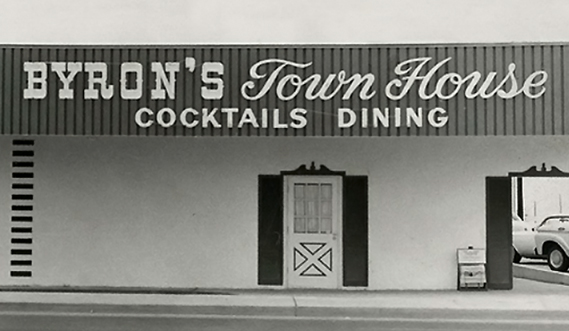

Sitting along the fringe of suburban expansion, youthful Danelle Plaza brought an injection of modern culture and live music options to Tempe in juxtaposition to its agricultural surroundings. In July 1964, Byron’s Town House opened with great flare, inviting Tempe to enjoy free hors d’oeuvres along with orchids for the ladies for a night of “Cocktails, Dining, and Dancing”. The centerpiece of this experience was its Hammond Organ with local organist Molly Tolby at the keys. Byron’s reflected the classic lounge scene of the 1960’s, defined by its relaxed, yet stylish and nuanced cocktail culture along with the ambient vibe of its jazz influenced soundtrack, but was cutting edge for Tempe. Out of the gate, modern Danelle Plaza was reflecting the community’s new suburban status and changing identity. Moreover, it was the beginning of nearly six decades of local live music at the plaza, representing Tempe’s growth and evolving music scene. In the following years, Byron’s Town House would change owners and be rebranded as Fireside Lounge with a similar live music emphasis.
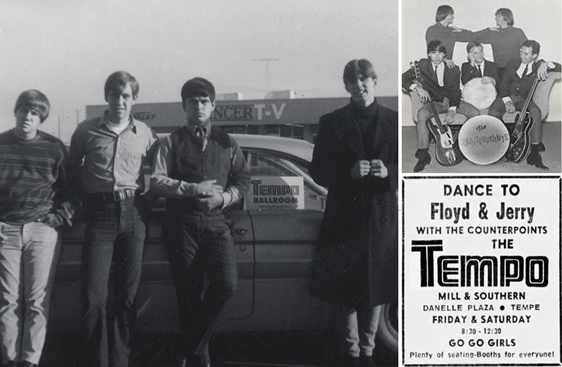
Not long after, the ‘Tempo Ballroom‘ opened in 1966, representing another live music venue at the plaza hoping to capitalize on popular culture. Driven by a surge in ‘British Invasion’ inspired garage bands and their expansive youth fanbase, Tempo reflected a wave of new live music venues appearing across the country. These spaces offered a dedicated scene for young fans to hang out, dance and listen to local live music. In turn, it gave local bands a formal setting to showcase original music and gain performance experience outside of more institutional environments. Tempo was a ‘dry’ venue, and intended to provide a tethered environment for local youth, but nevertheless allowed them to explore new sounds and ideas amongst their peers within a period of significant social, political and cultural change within the United States. Music lineups regularly included performances by Tempe’s own popular teen garage band ‘The Hearsemen’ (left), which would morph into ‘The Hobbit’ later that same year, along with a range of other music styles including ‘Hal Sunday’s 10-Piece’, ‘Jim Rowden & The Ranch Boys’, and ‘Floyd & Jerry with the Counterpoints’ (upper right).

Not long after, the ‘Tempo Ballroom‘ opened in 1966, representing another live music venue at the plaza hoping to capitalize on popular culture. Driven by a surge in ‘British Invasion’ inspired garage bands and their expansive youth fanbase, Tempo reflected a wave of new live music venues appearing across the country. These spaces offered a dedicated scene for young fans to hang out, dance and listen to local live music. In turn, it gave local bands a formal setting to showcase original music and gain performance experience outside of more institutional environments. Tempo was a ‘dry’ venue, and intended to provide a tethered environment for local youth, but nevertheless allowed them to explore new sounds and ideas amongst their peers within a period of significant social, political and cultural change within the United States. Music lineups regularly included performances by Tempe’s own popular teen garage band ‘The Hearsemen’ (left), which would morph into ‘The Hobbit’ later that same year, along with a range of other music styles including ‘Hal Sunday’s 10-Piece’, ‘Jim Rowden & The Ranch Boys’, and ‘Floyd & Jerry with the Counterpoints’ (upper right).
In contrast to Danelle Plaza’s streak of modern live music venues through the 1960’s, a quiet sliver of a country bar also opened at Danelle Plaza named ‘Frank’s Yucca Lounge‘ complete with live yucca plants along the sidewalk on Southern Avenue. Despite Tempe’s suburban growth boom, south Tempe was still largely a rural community, rooted in cowboy and ‘western’ culture. So, Yucca spoke to this demographic, featuring live country music and Mexican food, but was equally not above having go-go dancers on occasion. In 1972, Peter Hu purchased the bar from the original owners and rebranded as the ‘Yucca Tap Room‘ as it’s known today. Mr. Hu rolled with the original concept, appreciating its live country music theme and neighborhood vibe. Impressively, the interior still houses some of the original paneling, creating a unique time capsule that regulars swear by as a local landmark. Yucca’s humble beginnings as a small stage venue and community driven space would help define its evolution as a local live performance venue and its place within Tempe’s music scene for decades to come.
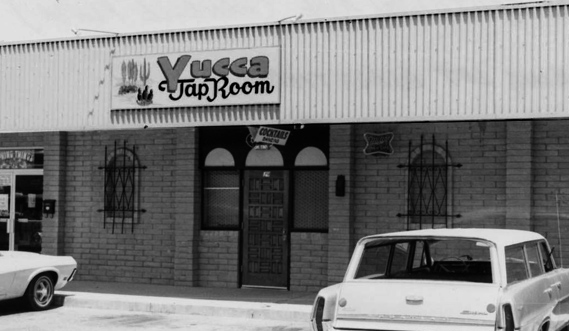

In contrast to Danelle Plaza’s streak of modern live music venues through the 1960’s, a quiet sliver of a country bar also opened at Danelle Plaza named ‘Frank’s Yucca Lounge‘ complete with live yucca plants along the sidewalk on Southern Avenue. Despite Tempe’s suburban growth boom, south Tempe was still largely a rural community, rooted in cowboy and ‘western’ culture. So, Yucca spoke to this demographic, featuring live country music and Mexican food, but was equally not above having go-go dancers on occasion. In 1972, Peter Hu purchased the bar from the original owners and rebranded as the ‘Yucca Tap Room‘ as it’s known today. Mr. Hu rolled with the original concept, appreciating its live country music theme and neighborhood vibe. Impressively, the interior still houses some of the original paneling, creating a unique time capsule that regulars swear by as a local landmark. Yucca’s humble beginnings as a small stage venue and community driven space would help define its evolution as a local live performance venue and its place within Tempe’s music scene for decades to come.
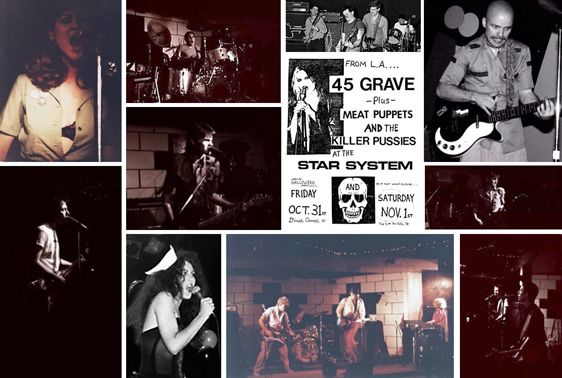
While still maintaining its understated daytime neighborhood vibe through the 1970’s, the arrival of ‘The Star System‘ in 1978 (now Q & Brew) transformed the plaza into a nocturnal destination for the Valley’s emerging punk and new wave scene. Initially intended as a disco, complete with a darkened interior, immersive canopy of twinkling stars, and pulsing dance floor, its ownership quickly ditched this original concept and started a regular flow of new wave and punk performances, acting as a gateway venue for southern California’s regional tour circuit. The Star System was an important step for the local new wave and punk community because there really wasn’t a dedicated stage for the fledgling scene up to that point. The venue’s sizeable space, proximity to ASU and liquor license, allowed promoters to draw regular high profile acts, including ‘The Go-Gos’, ‘The Plugz’ and ‘Fear’ while serving as a proving ground and launching pad for the Valley’s own evolving counterculture sound, including local bands such as ‘Billy Clone and the Same’, ‘The Nervous’, ‘Blue Shoes’, ‘The Feederz’, ‘Lucky High’, ‘Killer Pussy’, ‘Meat Puppets’ and ‘Mark Hoffman and the Rabble’. In turn, their loyal and expanding following was rewarded with a stream of original music, and a place where the Valley’s punk and new wave community could call their own.

While still maintaining its understated daytime neighborhood vibe through the 1970’s, the arrival of ‘The Star System‘ in 1978 (now Q&Brew) transformed the plaza into a nocturnal destination for the Valley’s emerging punk and new wave scene. Initially intended as a disco, complete with a darkened interior, immersive canopy of twinkling stars, and pulsing dance floor, its ownership quickly ditched this original concept and started a regular flow of new wave and punk performances, acting as a gateway for southern California’s regional tour circuit. This was an important step for local new wave and punk scene, because there wasn’t a consistent and dedicated base for shows until The Star System arrived. The venue’s sizeable space, proximity to ASU and liquor license, allowed promoters to draw regular high profile acts, including ‘The Go-Gos’, ‘The Plugz’ and ‘Fear’, while serving as a proving ground and launching pad for the Valley’s own evolving counterculture sound, including local bands such as ‘Billy Clone and the Same’, ‘The Nervous’, ‘Blue Shoes’, ‘The Feederz’, ‘Lucky High’, ‘Killer Pussy’, ‘Meat Puppets’ and ‘Mark Hoffman and the Rabble’. Its loyal and expanding following was rewarded with a stream of original local music, and a place where the Valley’s punk and new wave scene could call their own.
Following a change in ownership, The Star System was rebranded as ‘Merlin’s‘ in 1980, continuing to build on its new wave and punk oriented scene. ‘The Jetzons’ became Merlin’s house band shortly after reopening, sharing the stage with other local groups such as the ‘Meat Puppets’, ‘Sun City Girls’, ‘Jodie Foster’s Army’ (JFA) and the Psalms while still drawing national tours including ‘Chelsea’, ‘The Textones’ and ‘The Ventures’. Merlin’s was a local cultural laboratory, serving as a welcoming testbed for original music and new sounds from a seemingly endless rotation of experimental bands. Along with punk and new wave mainstays, the venue supported a diverse range of influences including country, funk, reggae and rock-a-billy, largely unified with the thread of anti-authoritarianism and resistance to mainstream culture expressed through their performance style and lyrics. In contrast to a largely conservative local landscape, Merlin’s is remembered by many as a place for alternative ideas – an escape from the suburban mainstream, with a loyal bohemian, artistic and intellectual patronage surfacing for show nights, reflecting the scene’s experimental identity and energy
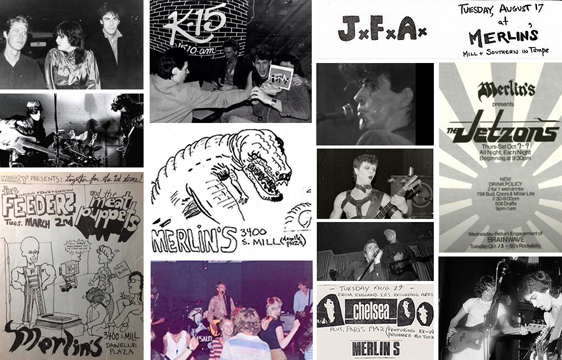

‘The Star System‘ switched ownership and was rebranded as ‘Merlin’s‘ in 1980, continuing to build on its new wave and punk oriented scene. ‘The Jetzons’ became Merlin’s house band shortly after reopening, sharing the stage with other local groups such as the ‘Meat Puppets’, ‘Sun City Girls’, ‘Jodie Foster’s Army’ (JFA) and the ‘Psalms’ while still drawing national tours including ‘Chelsea’, ‘The Textones’ and ‘The Ventures’. Merlin’s was a local cultural laboratory, serving as a welcoming testbed for original music and new sounds from a seemingly endless rotation of experimental bands. Along with punk and new wave mainstays, the venue supported a diverse range of influences including country, funk, reggae and rock-a-billy, largely unified with the thread of anti-authoritarianism and resistance to mainstream culture expressed through their performance style and lyrics. In contrast to a largely conservative local landscape, Merlin’s is remembered by many as a place for alternative ideas – an escape from the suburban mainstream, with a loyal bohemian, artistic and intellectual patronage surfacing for show nights, reflecting the scene’s experimental identity and energy.
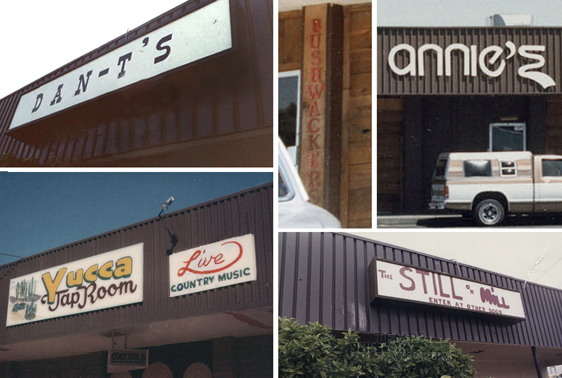
Interestingly, Merlin’s was actually one of several small live stages scattered around Danelle Plaza during late 1970’s and early 1980’s, including Dan T’s (Blues and Rock), The Still on Mill (R&B), Bushwacker’s Lounge (Country and Rock) which was eventually replaced by Annie’s (Country and Blue Grass), and Yucca Tap Room (Country) with its house band ‘Coyote’. These were accessible, low-key stages where local live performers could hone their skills and make a few bucks. In fact, Arizona Blues Hall of Famer Matt Roe had his first stage performance at Dan T’s in 1979. More often than not, live performers were hired to cover popular music, but sometimes a bar owner might let them float out some original material here and there. Nevertheless, these type of hole-in-the-wall stages provided a base of opportunity for local performers to acquire experience, make connections with the community, and ideally build a fan base. This sort of environment was not really unique to Danelle Plaza, but reflected a healthy network of small neighborhood stages across the city that would play an important role as Tempe moved into the national music spotlight during the 1990’s.

Interestingly, Merlin’s was actually one of several small live stages scattered around Danelle Plaza during late 1970’s and early 1980’s, including Dan T’s (Blues and Rock), The Still on Mill (R&B), Bushwacker’s Lounge (Country and Rock) which was eventually replaced by Annie’s (Country and Blue Grass), and Yucca Tap Room (Country) with its house band ‘Coyote’. These were accessible, low-key stages where local live performers could hone their skills and make a few bucks. In fact, Arizona Blues Hall of Famer Matt Roe had his first stage performance at Dan T’s in 1979. More often than not, live performers were hired to cover popular music, but sometimes a bar owner might let them float out some original material here and there. Nevertheless, these type of hole-in-the-wall stages provided a base of opportunity for local performers to acquire experience, make connections with the community, and ideally build a fan base. This sort of scene was not really unique to Danelle Plaza, but reflected a healthy network of small neighborhood stages across the city that would play an important role as Tempe moved into national music spotlight during the 1990’s.
With the closure of Merlin’s in 1983, Danelle Plaza lost its core music destination and its alternative scene migrated to other hubs across Tempe’s expanding ecology of venues including the Sun Club and Long Wong’s. However, much of the live music experimentation done at Danelle Plaza was still having its impact. By the early 1990’s, Tempe’s music scene was white hot, driven by the ‘Gin Blossoms’, ‘The Meat Puppets’ and other bands who started formulating their sound at The Star System and Merlin’s years earlier. Interestingly, the local music scene’s success was creating an overwhelming demand for performance space in close proximity to downtown Tempe, causing new bands in particular to start looking further out for accessible stages. Yucca Tap Room was no exception, with the traditionally ‘country styled’ bar opening its doors to several local alternative bands, including ‘The Refreshments’. Soon, Yucca’s small neighborhood stage was part of a growing network of outpost venues supporting Tempe’s live music renaissance – the local alternative scene had come full circle, returning to Danelle Plaza.
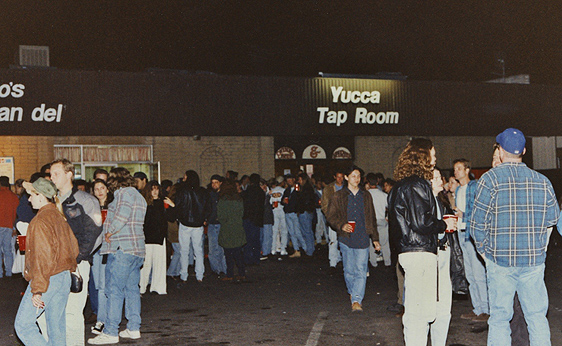

With the closure of Merlin’s in 1983, Danelle Plaza lost its most popular music destination, and its alternative scene migrated to other hubs across Tempe’s expanding ecology of venues including the Sun Club and Long Wong’s. However, much of the live music experimentation done at Danelle Plaza was still having its impact. By the early 1990’s, Tempe’s music scene was white hot, driven by the ‘Gin Blossoms’, ‘Meat Puppets’ and other bands who started formulating their sound at The Star System and Merlin’s years earlier. Interestingly, the local music scene’s success was creating an overwhelming demand for performance space in close proximity to downtown Tempe, causing new bands in particular to start looking further out for accessible stages. Yucca Tap Room was no exception, with the traditionally ‘country styled’ bar opening its doors to several local alternative bands, including ‘The Refreshments’. Soon, Yucca’s small neighborhood stage was part of a growing network of outpost venues supporting Tempe’s live music renaissance – the local alternative scene had come full circle, returning to Danelle Plaza.
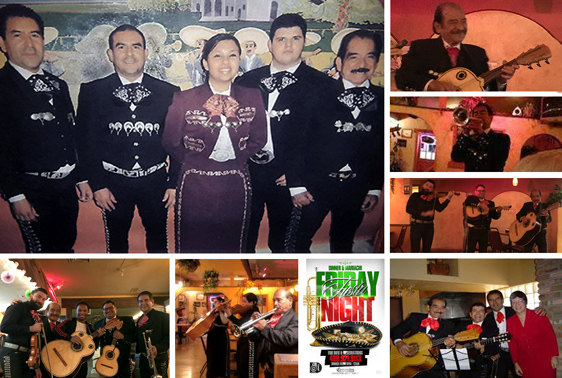
While Danelle Plaza had reclaimed its identity as a local alternative music destination, it was also revisiting its western roots with the arrival of Cervantes Mexican Restaurant in 2000. Reflecting over 100 years of mariachi heritage spanning several generations, the Cervantes family brought a rich history of live music to the plaza. The Cervantes family story began in Jalisco and Nayarit, Mexico where their unique style and sound included the hand crafting of mariachi instruments. Over the years, their reputation grew and were even selected to perform for John F Kennedy during his visit to Phoenix in 1961. The Cervantes immigrated to the United States, and became a mainstay within the Arizona mariachi community, performing at local and statewide music events throughout the decades, including Chris Cervantes appearing in a music video with Cheap Trick. Today, Cervantes Restaurant continues to showcase its culinary and music heritage, while also serving as a hub for the local Hispanic and mariachi community as a place to share, explore and honor the craft. In fact, you’ll often find local performers organically joining in during its Friday evening mariachi shows.

While Danelle Plaza had reclaimed its identity as a local alternative music destination, it was also revisiting its western roots with the arrival of Cervantes Mexican Restaurant in 2000. Reflecting over 100 years of mariachi heritage spanning several generations, the Cervantes family brought a rich history of live music to the plaza. The Cervantes family story began in Jalisco and Nayarit, Mexico where their unique style and sound included the hand crafting of mariachi instruments. Over the years, the family’s reputation grew and they were even selected to perform for John F Kennedy during his visit to Phoenix in 1961. The Cervantes immigrated to the United States, and became a mainstay within the Arizona mariachi community, performing at local and statewide music events throughout the decades, including Chris Cervantes appearing in a music video with Cheap Trick. Today, Cervantes Restaurant continues to showcase its culinary and music heritage, while also serving as a hub for the local Hispanic and mariachi community as a place to share, explore and honor the craft. In fact, you’ll often find local performers organically joining in during its Friday evening mariachi shows.
In its own way, Yucca Tap Room was also becoming a heritage site for local live music as Tempe’s entertainment scene continued to evolve. While the Tempe sound was still reverberating along Mill Avenue and on radio stations across the country, the downtown scene was slowly collapsing by the early 2000’s. Local music preferences were evolving, trending towards electronic dance and DJ driven shows, drawing attendance from the live stage venues. In turn, the rich network of downtown venues began fading away, including Long Wong’s in 2004. Yet, against the trend, Yucca Tap Room held its ground – continuing its nightly live music sets while headlining mainstay local indie performances. For many, Yucca Tap Room’s stage became recognized as the ‘last stand’ for Tempe’s live music scene, and a touchstone for the community experience that took place in the 1990s – not only because the venue still supported local live music but because Yucca played an authentic role in its development and history. Today, Yucca Tap Room continues on as a living legend at Danelle Plaza, echoing an era of local cultural experimentation and growth that influenced the national soundtrack.
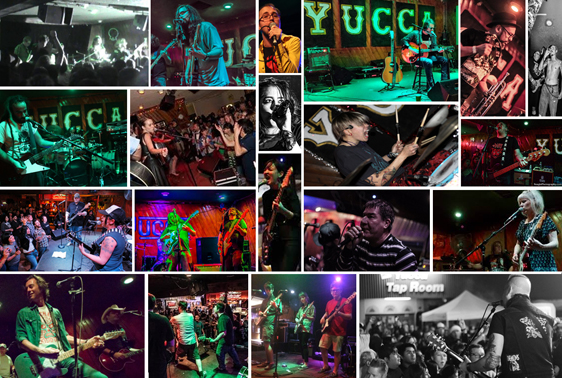

In its own way, Yucca Tap Room was also becoming a heritage site for local live music as Tempe’s entertainment scene continued to evolve. While the Tempe sound was still reverberating along Mill Avenue and on radio stations across the country, the downtown scene was slowly collapsing by the early 2000’s. Local music preferences were evolving, trending towards electronic dance and DJ driven shows, drawing attendance from the live stage venues. In turn, the rich network of downtown venues began fading away, including Long Wong’s in 2004. Yet, against the trend, Yucca Tap Room held its ground – continuing its nightly live music sets while headlining mainstay local indie performances. For many, Yucca Tap Room’s stage became recognized as the ‘last stand’ for Tempe’s live music scene, and a touchstone for the community experience that took place in the 1990s – not only because the venue still supported local live music but because Yucca played an authentic role in its development and history. Today, Yucca Tap Room continues on as a living legend at Danelle Plaza, echoing an era of local cultural experimentation and growth that influenced the national soundtrack.
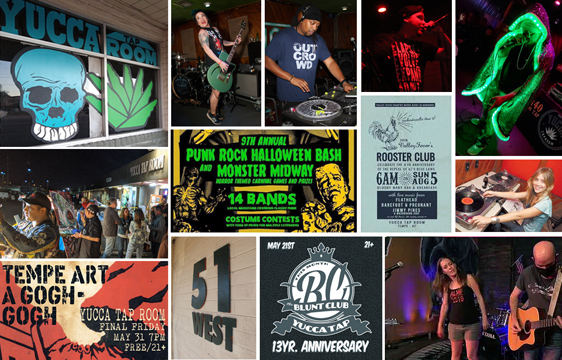
Looking back on the plaza’s history, if anything is consistent, it is that Tempe’s music scene continues to evolve. This is something Yucca Tap Room has recognized and embraced, maintaining an inclusive and accessible attitude towards changing trends within the local music and arts community – never losing sight of Peter Hu’s perspective that Yucca was first and foremost a place for community, a legacy that Rodney Hu continued after taking over ownership. In 2010, Yucca Tap Room expanded, adding a new lounge including a DJ station – diversifying its sound while still maintaining the seasoned vibe of the original space. Yucca also collaborated with The Nile Theater to create the all-ages live music venue 51 West, providing an authentic stage experience for young performers, often with families in tow. Yucca has also hosted a diverse base of local music and art programs including country themed Valley Fever and Rooster Club, the hip-hop styled Blunt Club and the long running live music and art showcase, Tempe Art A Gogh-Gogh.

Looking back on the plaza’s history, if anything is consistent, it is that Tempe’s music scene continues to evolve. This is something Yucca Tap Room has recognize and embraced, maintaining an inclusive and accessible attitude towards changing trends within Tempe’s music and arts community, never losing sight of Peter Hu’s perspective that Yucca was first and foremost a place for community, a legacy that Rodney Hu continued after taking over ownership. In 2010, Yucca Tap Room expanded, adding a new lounge including a DJ station – diversifying its sound while still maintaining the seasoned vibe of the original space. Yucca also collaborated with The Nile Theater to create the all-ages live music venue 51 West, providing an authentic stage experience for young performers, often with families in tow. Yucca has also hosted a diverse base of local music and art programs including country themed Valley Fever and Rooster Club, the hip-hop styled Blunt Club and the long running live music and art showcase, Tempe Art A Gogh-Gogh.
Danelle Plaza’s music legacy is a reminder of the critical role that understated and neighborhood scale places can play within the growth and development of local culture, and that the dynamic nature of creative scenes leverage diverse and non-traditional community spaces to adapt and evolve. It could be that the plaza has served as ‘Tempe’s garage’ within its suburban identity, a place where the rules were more loose, making a mess was more tolerated, and creating some noise was less of an issue. Indeed, the humble ‘garage’ is where America has made some of its most significant leaps in innovation during the modern era. For nearly sixty years, Danelle Plaza’s live music scene has served a cultural laboratory exploring new sounds and ideas that helped Tempe develop its local identity while contributing to the sound of alternative music at a national level. The plaza’s music legacy continues on today, a place where Tempe can honor its music heritage while supporting the next generation of artists – the beat goes on.
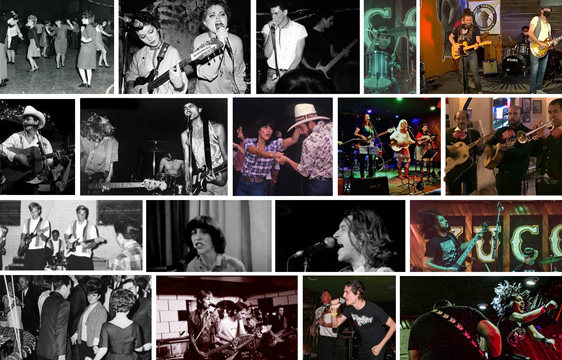

Danelle Plaza’s music legacy is a reminder of the critical role that understated and neighborhood scale places can play within the growth and development of local culture, and that the dynamic nature of creative scenes leverage diverse and non-traditional community spaces to adapt and evolve. It could be that the plaza has served as ‘Tempe’s garage’ within its suburban identity, a place where the rules were more loose, making a mess was more tolerated, and creating some noise was less of an issue. Indeed, the humble ‘garage’ is where America has made some of its most significant leaps in innovation during the modern era. For nearly sixty years, Danelle Plaza’s live music scene has served as a cultural laboratory, exploring new sounds and ideas that helped Tempe develop its local identity while influencing the sound of alternative music at a national level. The plaza’s music legacy continues on today, a place where Tempe can honor its music heritage while supporting the next generation of artists – the beat goes on.
Interested in contributing your memories and photos regarding Danelle Plaza’s music legacy? Please don’t hesitate to reach out to us – we look forward to hearing from you!:
contact@thedanelleproject.org
Copyright 2025, The Danelle Project